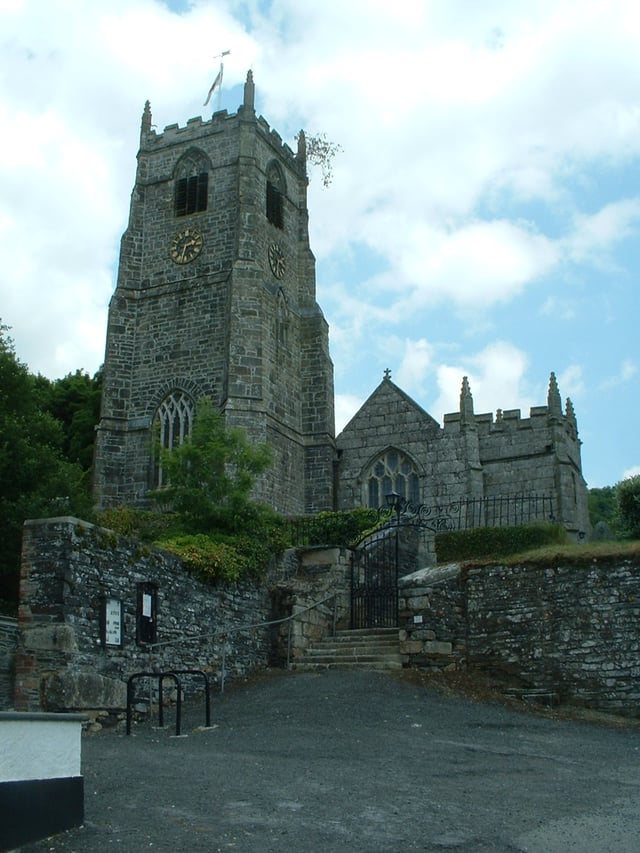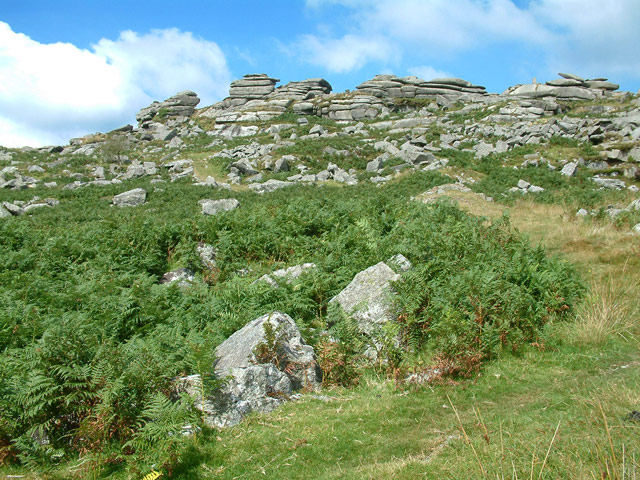Bodmin Moor

Bodmin Moor

Rough Tor
Bodmin Moor (Cornish: Goon Brenn)[1] is a granite moorland in northeastern Cornwall, England. It is 208 square kilometres (80 sq mi) in size, and dates from the Carboniferous period of geological history. It includes Brown Willy, the highest point in Cornwall, and Rough Tor, a slightly lower peak. Many of Cornwall's rivers have their sources here. It has been inhabited since at least the Neolithic era, when primitive farmers started clearing trees and farming the land. They left their megalithic monuments, hut circles and cairns, and the Bronze Age culture that followed left further cairns, and more stone circles and stone rows. By medieval and modern times, nearly all the forest was gone and livestock rearing predominated.
Geography
Dramatic granite tors rise from the rolling moorland: the best known are Brown Willy, the highest point in Cornwall at 417 m (1,368 ft),[5] and Rough Tor at 400 m (1,300 ft). To the south-east Kilmar Tor and Caradon Hill are the most prominent hills.[6] Considerable areas of the moor are poorly drained and form marshes (in hot summers these can dry out). The rest of the moor is mostly rough pasture or overgrown with heather and other low vegetation.[7]
The moor contains about 500 holdings with around 10,000 beef cows, 55,000 breeding ewes and 1,000 horses and ponies.[8] Most of the moor is a Site of Special Scientific Interest (SSSI), Bodmin Moor, North,[9] and has been officially designated an Area of Outstanding Natural Beauty (AONB), as part of Cornwall AONB.[10] The moor has been identified by BirdLife International as an Important Bird Area (IBA) because it supports about 260 breeding pairs of European stonechats as well as a wintering population of 10,000 Eurasian golden plovers.[11] The moor has also been recognised as a separate natural region and designated as national character area 153 by Natural England.[12]
Rivers and inland waters

Siblyback Lake

The De Lank River at Garrow Tor
Bodmin Moor is the source of several of Cornwall's rivers: they are mentioned here anti-clockwise from the south.
The River Fowey rises at a height of 290 m (950 ft) and flows through Lostwithiel and into the Fowey estuary.[13]
The River Tiddy rises near Pensilva and flows southeast to its confluence with the River Lynher (the Lynher flows generally south-east until it joins the Hamoaze near Plymouth). The River Inny rises near Davidstow and flows southeast to its confluence with the River Tamar.[14]
The River Camel rises on Hendraburnick Down and flows for approximately 40 km (25 mi) before joining the sea at Padstow.[15] The River Camel and its tributary the De Lank River are an important habitat for the otter, and both have been proposed as Special Areas of Conservation (SAC)[16] The De Lank River rises near Roughtor and flows along an irregular course before joining the Camel south of Wenford.[14]
The River Warleggan rises near Temple and flows south to join the Fowey.[6]
On the southern slopes of the moor lies Dozmary Pool. It is Cornwall's only natural inland lake and is glacial in origin. In the 20th century three reservoirs have been constructed on the moor; these are Colliford Lake, Siblyback Lake and Crowdy reservoirs, which supply water for a large part of the county's population. Various species of waterfowl are resident around these waters.[17]
Parishes

Church in St Neot
The parishes on the moor are as follows:
|
|
History and antiquities
Prehistoric times

King Arthur's Hall

Kilmar Tor
10,000 years ago, in the Mesolithic period, hunter-gatherers wandered the area when it was wooded. There are several documented cases of flint scatters being discovered by archaeologists, indicating that these hunter-gatherers practised flint knapping in the region.[18]
During the Neolithic era, from about 4,500 to 2,300 BC, people began clearing trees and farming the land. It was also in this era that the production of various megalithic monuments began, predominantly long cairns (three of which have currently been identified, at Louden, Catshole and Bearah) and stone circles (sixteen of which have been identified). It was also likely that the naturally forming tors were also viewed in a similar manner to the manmade ceremonial sites.[18]
In the following Bronze Age, the creation of monuments increased dramatically, with the production of over 300 further cairns, and more stone circles and stone rows.[18] More than 200 Bronze Age settlements with enclosures and field patterns have been recorded.[19] and many prehistoric stone barrows and circles lie scattered across the moor. In a programme shown in 2007 Channel 4's Time Teaminvestigated a 500-metre cairn and the site of a Bronze Age village on the slopes of Rough Tor.[20]
King Arthur's Hall, thought to be a late Neolithic or early Bronze Age ceremonial site, can be found to the east of St Breward on the moor.[21]
Medieval and modern times

Hawk's Tor, west of North Hill
Where practicable, areas of the moor were used for pasture by herdsmen from the parishes surrounding the moor. Granite boulders were also taken from the moor and used for stone posts and to a certain extent for building (such material is known as moorstone).[22] Granite quarrying only became reasonably productive when gunpowder became available.
The moor gave its name (Foweymore) to one of the medieval districts called stannaries which administered tin mining: the boundaries of these were never defined precisely. Until the establishment of a turnpike road through the moor (the present A30) in the 1770s the size of the moorland area made travel within Cornwall very difficult.[23]
Its Cornish name, Goen Bren, is first recorded in the 12th century.[24]
Jamaica Inn is a traditional inn on the Moor. Built as a coaching inn in 1750 and having an association with smuggling, it was used as a staging post for changing horses.
Monuments and ruins
Roughtor was the site of a medieval chapel of St Michael and is now designated as a memorial to the 43rd Wessex Division of the British Army. In 1844 on Bodmin Moor the body of 18-year-old Charlotte Dymond was discovered. Local labourer Matthew Weeks was accused of the murder, and at noon on 12 August 1844 he was led from Bodmin Gaol and hanged. The murder site now has a monument erected from public money, and the grave is at Davidstow churchyard.[27]
Legends and traditions
The Beast of Bodmin has been reported many times but never identified with certainty.[29]
Film
See also
List of topics related to Cornwall
Brown Willy effect
Jamaica Inn (novel)


